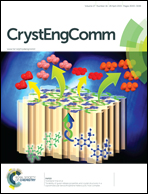Structural diversity in new coordination polymers modulated by semirigid ether-linked pyridine-phthalate building block and ancillary ligands: syntheses, structures, and luminescence properties†
Abstract
Seven new 2D or 3D coordination polymers based on the flexible and semirigid pyridine-phthalate building block H2pbda (3-(pyridin-3-yloxy)benzene-1,2-dicarboxylic acid), namely 3D [Cd(pbda)]n (1), 3D [Cd3(OH)2(pbda)2]n (2), 3D [Cd(pbda)(4,4′-bpy)]n (3), 3D {[Co(pbda)(4,4′-bpy)]·2H2O}n (4), 2D {[Zn(pbda)(1,4-bib)]·H2O}n (5), 2D {[Cd(pbda)(1,4-bib)]·H2O}n (6), and 3D {[Co(pbda)(4,4′-bibp)]·2H2O}n (7), were prepared by hydrothermal reactions in the presence (optional) of an ancillary ligand selected from 4,4′-bpy (4,4′-bipyridine), 1,4-bib (1,4-bis(imidazol)butane), or 4,4′-bibp (bis(benzimidazol)propane). Compounds 1–7 were fully characterized and their crystal structures were classified from the topological viewpoint, resulting in the following topological networks: gis in 1, crb in 2, ins in 3 and 7, fsc-3,4-C2/c in 4, and sql in 5 and 6. The results revealed that the crystal architectures and the coordination modes of pbda building blocks are influenced by various factors, including the nature of metal cations, the solution pH, the temperature, and the presence of N-donor ancillary ligands. In addition, TGA data show that almost all compounds are thermally stable up to 300 °C. Zn(II) and Cd(II) derivatives are also strong luminescent emitters.


 Please wait while we load your content...
Please wait while we load your content...